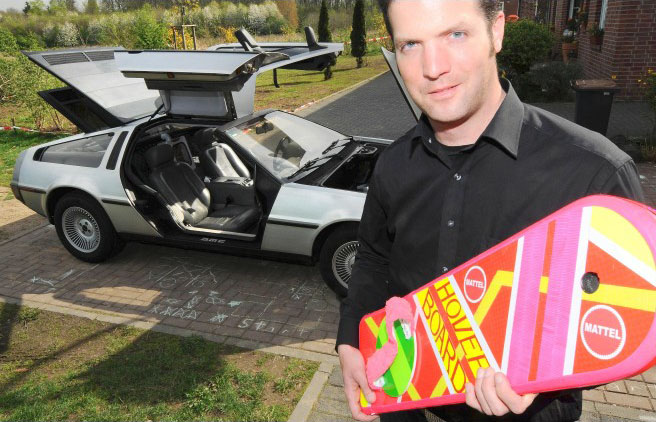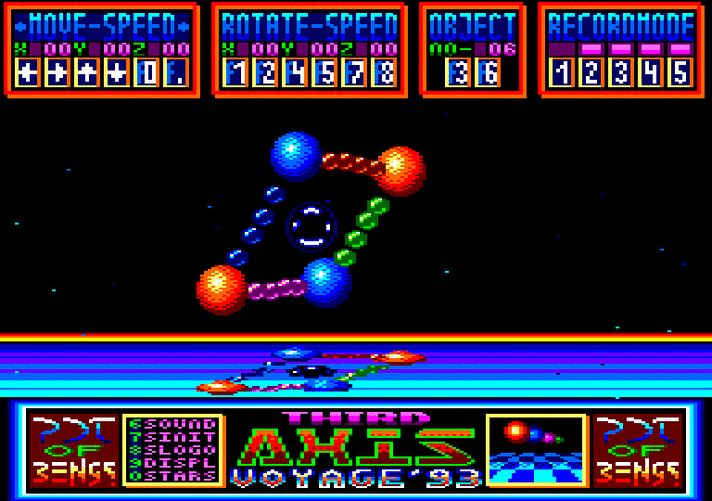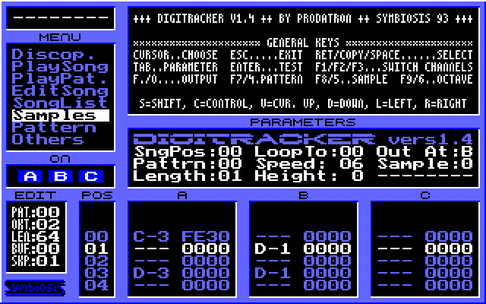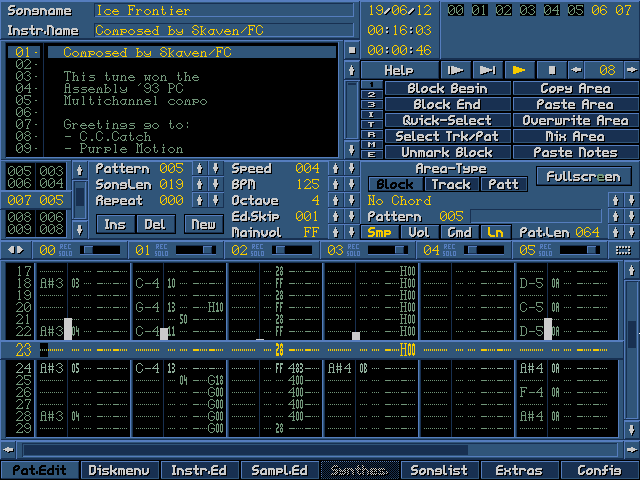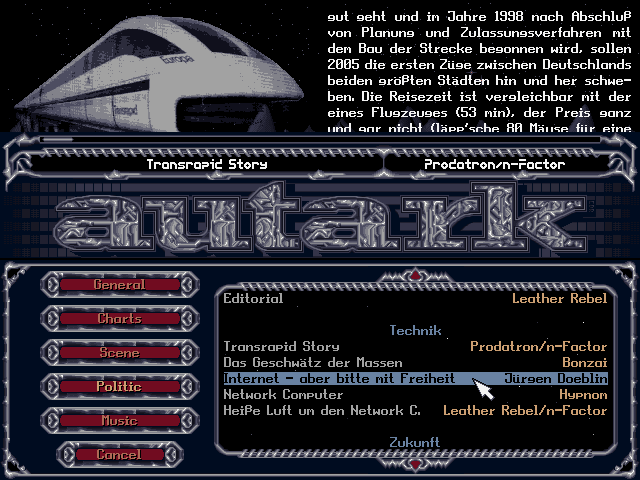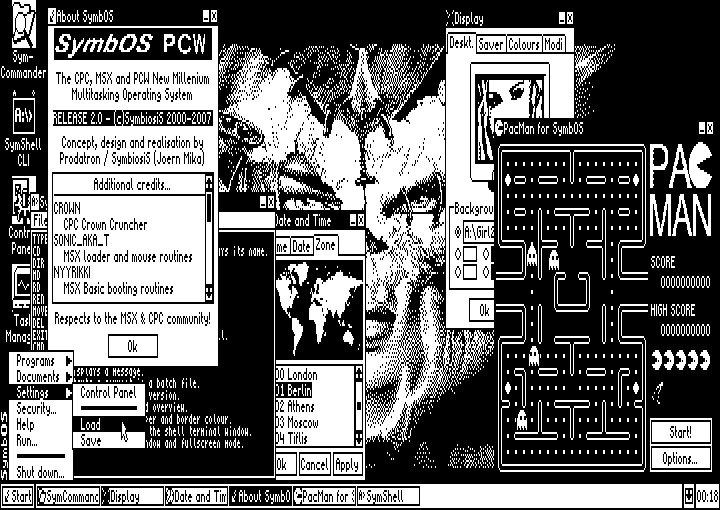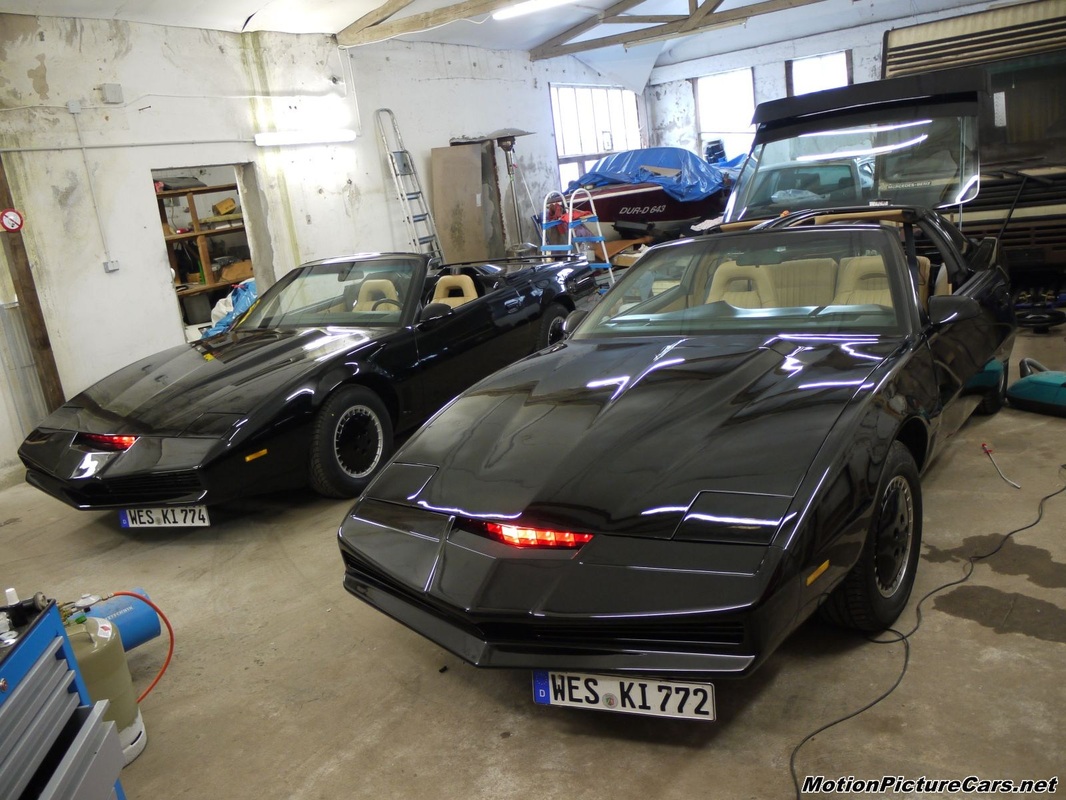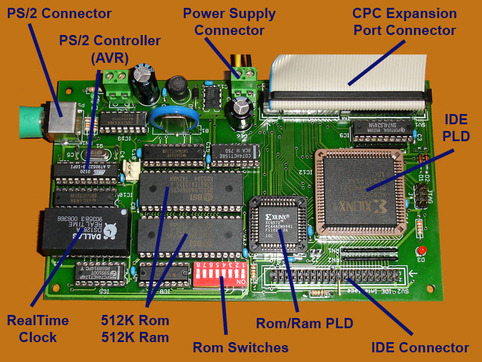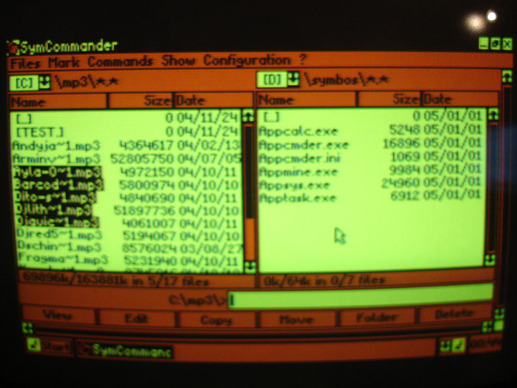Interview of Prodatron / SymbiosiS (June 2012)
Jörn, also known under the name of Prodatron in the demoscene, is famous for his impressive Amstrad CPC productions. During 1993-94, at a time where demos were all about big scrollers and tricky other hardware effects, he definitively gave a new fresh air of creativity by pushing Amstrad CPC limits with realtime 3D and soundtrack MOD player/editor. I was curious to know more about him, for his past work but also about his more recent one, so I'm really kind of glad he accepted to answer my questions !
1. Hi Jörn. Can you briefly present yourself ? (your age, country, your job..)
Hi Arnaud, thanks a lot for beeing so patient with this interview! I am 37 years old and live in Moers, Germany, a town close to the dutch border. Since 1999 I am self employed and working in the internet business. I am currently a technical project manager in one of our companies, which is developing web applications for several clients.
2. How did you learn programming on Amstrad CPC ? How old were you at the time ?
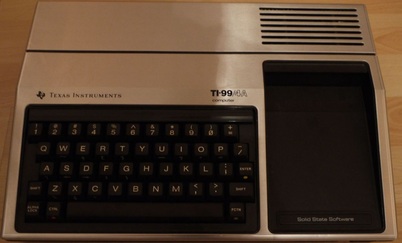
Texas Instruments TI99/4A, the first 16-bit personal computer
In a regular way I started programming on the Amstrad CPC end of 1987. In early 1983, when I was 8 years old, I saw a homecomputer the first time in my life: It was a Sinclair ZX-81, and I was so fascinated about its char-plotting cursor! My father was a mathematic teacher. In these days they introduced informatics as a new subject in schools for the first time here. They didn't have any informatic teachers, so my father had to do this job. To get some experiences he took a ZX-81 and later a TI99/4A from school to our home. So on the TI99/4A I made my first Basic experiences 1983/1984. Later my father moved to another school and unfortunately he couldn't bring any computers home. I had to write Basic programs on some paper sheets, hoping that they could become reality on a real computer somewhen in the future. 1985 I was interested in a C64 for a short time. But my father studied the specs of both the C64 and the CPC and convinced me to have a closer look at the Schneider (the german reseller of the Amstrad). I did it and I started to love this machine at once! At these days we had a store which always exposed running computers, where you even could code and trial your own programs. So between 1985 and 1987 I spent a lot of time in this store coding simple basic games and tools on the Amstrad CPC - without the possibility to save them to disc. It took me about 3 years until I collected enough pocket money to be able to buy my own CPC-6128 at the end of 1987. This machine is still my main CPC now.
3. What is your preferred demo you created and why ?
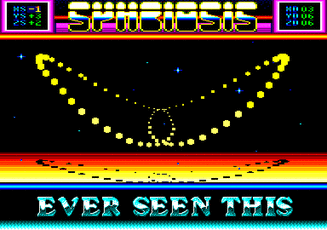
Digital Orgasm by Prodatron
My preferred one is the Digital Orgasm demo. When I coded this demo end of 1993 I was a little bit sad, as I had the feeling that the CPC was more or less dead. The french scene, which was always the reference for me, wasn't very active at this time, and in Germany we "only" had Face Hugger and Odiesoft as the last active and very talented coders at all. Our BENG!s Voyage 1993 megademo was technically state of the art at this time, but the design wasn't perfect. At the end I didn't like it so much. We were very proud to have the 3D parts, but that's it. Prodatron Megademo, which I coded before, wasn't state of the art at all, but to be honest I had much more fun in coding and watching it. So after releasing CPC-DigiTracker in summer/autumn 1993 I wanted to code my second Megademo. We had BSC (music) and Made (one of the best graphic artist I met at this time) in our new group SymbiosiS. With these guys I was able to create some nice demo parts, which would be a good premise for a new megademo. But as I switched to the 80x86 platform at the beginning of 1994 I wasn't able to complete the whole work, and so I finished it under the name of Digital Orgasm. In 1994 I had no idea, that we would ever have this great rebirth of the CPC spirit thanks to the retro-movement!
4. Do you consider there was a "virtual war" between French and German Amstrad CPC demoscenes around 1988-93 ? Was bringing generalized realtime 3D the final answer from Germany ?
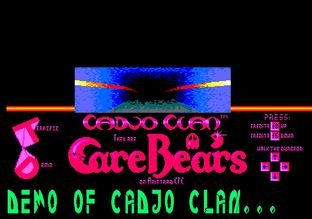
Terrific Demo by Cadjo Clan
Maybe something like this was going on at these days. There was always a competition between all the demo groups, and in most cases the french guys were the best ones. French groups used much better techniques and designs (e.g. Logon System, The Demo) than german groups (e.g. Cadjo Clan, Terrific Demo). With his demo S&KOH, Overflow created the most cutting-edge hardware-demo ever created on the old-gen CPC in my opinion - somehow it was unbeatable at this time. Only Elmsoft from Austria was nearly on the same level like the french guys.
Then Face Hugger appeared and released his Ultimate Megademo. It didn't have a great design, but its 3D- and software-parts were revolutionary for the CPC demoscene. That was quite motivating for us, and so we also started with vector graphics to catch up on our arrear to the french scene.
Then Face Hugger appeared and released his Ultimate Megademo. It didn't have a great design, but its 3D- and software-parts were revolutionary for the CPC demoscene. That was quite motivating for us, and so we also started with vector graphics to catch up on our arrear to the french scene.
5. Why can we read Prodatron Rejects Beng! (Bad European News Gang) on your website http://www.prodatron.net ? Was being a member of that team a bad experience to you ?
Ooops, I am so sorry for this misunderstanding!! :-)) The Rejects is the name of my first scene group which I founded together with Leather Rebel 1991/1992. Later we were moving to BENG! and I really had a great time there before we founded SymbiosiS in 1993. I just wanted to mention all my groups on the website, so it's funny that this lead to this misunderstanding :-)
6. You left Amstrad CPC for PC programming, in 1994-95. Then on PC you did Autark discmag, as also a new Digitrakker version.. then you stopped activities few times later. Why ? Was the PC demoscene a bad experience to you ?
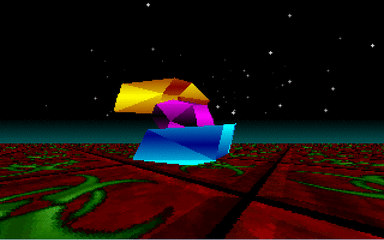
"1st Infection", PC demo by Prodatron (1994)
To be honest my time in the MS-DOS/80x86 demoscene between 1994-1996 was as great as in the CPC scene. There were a lot of reasons...
- In a certain way the PC environment of the early 90ies was very similiar to the CPC: a primitive operating system which you don't need at all if you want to do your own special stuff; you had direct and pure hardware control; with the exception of mass storage access you were able to low level-code everything including all the hardware stuff by yourself; especially the graphics
- VGA was the standard and it was fully compatible on all machines; it had nearly the same CRTC like the CPC with some additional registers
- Also on the PCs of these days you knew most of all the bits, bytes and ports of the whole machine; so everything was in your hands, if you were still coding in assembler
- You were coding in the same way and with the same spirit like on the CPC, but you had much more possibilities: more CPU registers and bits per register, a much faster CPU and more powerfull instructions; regarding the graphics you had the feeling, that now you can realize everything you had ever dreamed about including complex 3D vector worlds
- The scene was very huge and active; I visited much more demo parties than I did in the CPC scene in the years before
Then in 1996 everything changed. Using Super VGA screenmodes became more and more important. Unlike in the Standard VGA mode you didn't have compatiblity anymore, if you still wanted to do special hardware (CRTC) tricks and lowlevel coding. Also in 1996 Microsoft Windows 95 finally replaced MS-DOS completely. So the good old CPC-like low-level environment finally disappeared on the 80x86 platform forever!
Already in 1995 I discovered the World Wide Web, and so in 1996 I stopped coding 80x86 Assembler and started in the web development business. That was interesting, and you could make a lot of money in these early internet times, but that was by far not as cool as coding on the Z80 and the 80x86 in the early 90ies.
Already in 1995 I discovered the World Wide Web, and so in 1996 I stopped coding 80x86 Assembler and started in the web development business. That was interesting, and you could make a lot of money in these early internet times, but that was by far not as cool as coding on the Z80 and the 80x86 in the early 90ies.
7. In the beginning of 2000 you decided to get back on track with Amstrad CPC (then later for all z80-based 8 bits machines), by creating a new OS, SymbOS. Can you tell us more about it ?
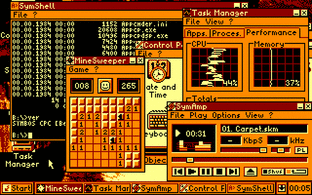
SymbOS (CPC version)
Already end of the 80ies I was dreaming about a graphical user interface for the CPC, which could compete with the Amiga Workbench. Some friends of mine owned this fantastic machine, and I was very enthused about its desktop system. I also saw some GEOS screenshots and was really envious of the C64 guys.
At the beginning of the 90ies I made a few attempts to build such a GUI for the CPC. I didn't had that much experience at this time, so CEUS Desktop 2.0 was the only finished result. It was probably useless for serious applications, and so I couldn't fulfill my dream.
10 years later I was a little bit bored by web-programming (my commercial job) and decided to have an eye on the 8bit world again. I still had the old dream about a powerfull CPC-GUI, and so I watched some C64-GEOS websites and also discovered the very interesting but unfinished C64 CLiPS project. Now I was a little bit wiser, was familiar with stuff like object oriented programming and multitasking, and so the SymbOS story began.
At the beginning of the 90ies I made a few attempts to build such a GUI for the CPC. I didn't had that much experience at this time, so CEUS Desktop 2.0 was the only finished result. It was probably useless for serious applications, and so I couldn't fulfill my dream.
10 years later I was a little bit bored by web-programming (my commercial job) and decided to have an eye on the 8bit world again. I still had the old dream about a powerfull CPC-GUI, and so I watched some C64-GEOS websites and also discovered the very interesting but unfinished C64 CLiPS project. Now I was a little bit wiser, was familiar with stuff like object oriented programming and multitasking, and so the SymbOS story began.
I started with the GUI routines first. SymbOS should run in all three CPC-screen resolutions. So I had to split the high- and lowlevel screen routines in a very clear way, as each resolution requires its own low level library. In summer 2001 I coded the microkernel with its multitasking process scheduler. The multitasking environment requires the encapsulating of all bankswitching routines inside the microkernel (accessing up to 1MB ram for running parallel processes on an 8bit system). It wasn't an intention in 2001 but only because of these two facts it was possible to port SymbOS to other Z80 platforms later. At the end of 2004 I was sure that SymbOS could become a reality exactly in the way how it was in my imaginations. My work together with Dr.Zed and Trebmint motivated me a lot, and in spring 2006 I could finally fulfill my 20 year old dream with the first official release of SymbOS.
8. Still about SymbOS, after many solid releases, I feel like you are not motivated anymore on the project. Are you demotivated by the fact only few people actually created programs for your OS?
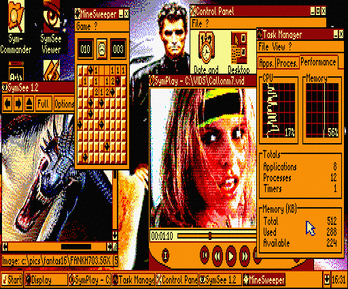
SymbOS (MSX version)
No, absolutely not. I never had a problem with that, I was just happy about the high interest and great feedback and that you could see SymbOS running on all the retro parties. Even people from other computer systems were speaking about it. It sounds funny, but in a way the contrary was one of the reasons. Especially in the MSX scene I got tons of feedback week by week and I had to help more and more people with stuff regarding SymbOS. So at the end I spent much more time in communicating with people than in the SymbOS development itself. In 2007 SymbOS was running on three different platforms, and especially the MSX platform included dozens of different machines from different manufacturers, using different floppy- and harddisc-controllers. I implemented exchangeable mass storage device drivers for SymbOS MSX and tried to support the most important ones, but it was depressing, that there were still a lot of unsupported systems and its users were asking for support again and again.
But the real reason, why I stopped my activities, was a different one. End of 2007 I started with a new hobby. Somehow it was a computer from the 80ies, too, but with four wheels. It's K.I.T.T., the speaking car of the 80ies television series Knight Rider with David Hasselhoff, which is a modified Pontiac Trans Am. This series was very popular in Germany, and as a small boy you admired this car a lot. Inadvertently I bought such a car end of 2007, but then started to like this hobby. I wanted to restore it completely and build a real KITT with all details including the cockpit-like dashboard. I also integrated a computer, which recognizes voice commands and is able to control many components of the car. It's finished now, and some more movie cars, like a DeLorean known from Back to the future, joined my collection, and that's what I have done during the last four years.
9. I remember Longshot from Logon System telling that SymbOS + Symbiface 2 (dedicated hardware able to handle extended memory, IDE hard-drive and much more..) was a new platform, not an Amstrad CPC anymore. What is your point of view about that?
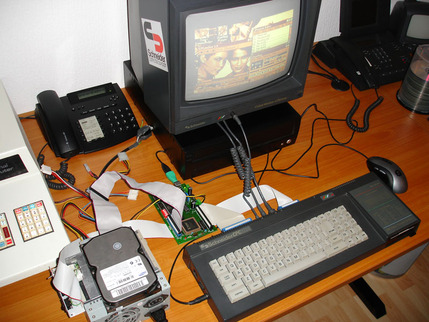
SymbOS + Symbiface 2
I don't know if I should understand this as a compliment or not. Maybe our stuff is so revolutionary, that people have the feeling that it's another platform and not the CPC from the mid-80ies. That's nice to hear! :)
But maybe Longshot isn't speaking about the philosophical but about the technical aspects of SymbOS and the SYMBiFACE II, that it would change the CPC core completely? In this case I totally disagree. Beside the realtime-clock and the RAM- and ROM-expansions, which already existed in the 80ies in exactly the same compatible way, the SYMBiFACE II is nothing more than a pure interface without any own intelligence. It doesn't replace any core part of the CPC, so the CPC itself is still the same machine. All work has still to be done by its little Z80 CPU - like fetching every single byte from the IDE harddrive. We already had interfaces in the 80ies like RS232 or even MFM harddisc controllers etc. The CPC core still stays the same of course.
But I remember some fairs, where people were watching SymbOS playing movies on a CPC with a SYMBiFACE II, and these guys really thought, that all the video stuff would be rendered and displayed by the SYMBiFACE II. This is of course totally wrong, everything is still handled by the CPC and its Z80.
But maybe Longshot isn't speaking about the philosophical but about the technical aspects of SymbOS and the SYMBiFACE II, that it would change the CPC core completely? In this case I totally disagree. Beside the realtime-clock and the RAM- and ROM-expansions, which already existed in the 80ies in exactly the same compatible way, the SYMBiFACE II is nothing more than a pure interface without any own intelligence. It doesn't replace any core part of the CPC, so the CPC itself is still the same machine. All work has still to be done by its little Z80 CPU - like fetching every single byte from the IDE harddrive. We already had interfaces in the 80ies like RS232 or even MFM harddisc controllers etc. The CPC core still stays the same of course.
But I remember some fairs, where people were watching SymbOS playing movies on a CPC with a SYMBiFACE II, and these guys really thought, that all the video stuff would be rendered and displayed by the SYMBiFACE II. This is of course totally wrong, everything is still handled by the CPC and its Z80.
The SYMBiFACE II is probably the most multifunctional hardware ever published for the CPC, and it was the first official one with an IDE interface. But you shouldn't mix it up with these beasts like the CMD SuperCPU for the C64, which transmutes the C64 machine into a stupid zombie graphic/keyboard-terminal, while all the work and intelligence is now done by the expansion card.
Regarding SymbOS: This operating system is designed for running on a naked CPC-6128 without any expansions - not even roms are required. Without additional memory you may only be able to start one bigger application or several smaller ones at the same time. Every other operating system for the CPC can't start more than one program at the same time, so what? The SYMBiFACE II and SymbOS is a nice combination, but you can still run SymbOS with 80ies hardware expansions in a fine way. You just need some more Ram (additional 256KB dk'tronics/Dobbertin is already more than enough) and that's it. An IDE harddisc is only needed for playing videos, everything else is possible with the original CPC hardware. So there is no reason to think, that SymbOS requires another platform.
SymbOS together with the SYMBiFACE II could be called a dream-team, but both of them can be used as stand-alone solutions, as they are not dependant on each other. From the technical side they are not changing the CPC into another platform at all. From the philosophical side: Yes, sure! :D
Regarding SymbOS: This operating system is designed for running on a naked CPC-6128 without any expansions - not even roms are required. Without additional memory you may only be able to start one bigger application or several smaller ones at the same time. Every other operating system for the CPC can't start more than one program at the same time, so what? The SYMBiFACE II and SymbOS is a nice combination, but you can still run SymbOS with 80ies hardware expansions in a fine way. You just need some more Ram (additional 256KB dk'tronics/Dobbertin is already more than enough) and that's it. An IDE harddisc is only needed for playing videos, everything else is possible with the original CPC hardware. So there is no reason to think, that SymbOS requires another platform.
SymbOS together with the SYMBiFACE II could be called a dream-team, but both of them can be used as stand-alone solutions, as they are not dependant on each other. From the technical side they are not changing the CPC into another platform at all. From the philosophical side: Yes, sure! :D
10. Do you still follow Amstrad CPC demoscene ? What do you think of demos released during the last 3 years, including the freshly released "Batman Forever" demo from Rhino?
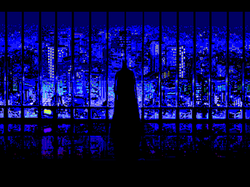
Of course sometimes I have a look at new productions for the Amstrad, and I am still as impressed as I was in the past, when watching new CPC demos. It's really cool, that it is still possible to create demos, which outperform older ones - that's somehow crazy!
I also like the newer CPC+ demos a lot, as on the technical side they are quite different and fresh compared to the classic CPC demos. When I got in touch with the MSX system I recognized, that a big amount of the demo effects are based on the line splitting technique, and I wondered why we didn't use this technique in this very extreme way on the CPC. Now I saw that Batman Forever finally did a great job here! And yes, the exzessive mixture of its fantastic software- and hardware-techniques is absolutely impressive.
I also like the newer CPC+ demos a lot, as on the technical side they are quite different and fresh compared to the classic CPC demos. When I got in touch with the MSX system I recognized, that a big amount of the demo effects are based on the line splitting technique, and I wondered why we didn't use this technique in this very extreme way on the CPC. Now I saw that Batman Forever finally did a great job here! And yes, the exzessive mixture of its fantastic software- and hardware-techniques is absolutely impressive.
11. What is your future regarding the Amstrad CPC, and from a more generalized point of view, the Z80 8-bits machines? Do you plan creating something new? Any chance to see a new Symbiosis production for the Amstrad CPC sooner or later?
During the last four years I was always hoping, that at one day I would come back to the Z80 and the SymbOS platform. I am still visiting retro-meetings on a regular basis and sometimes I started to code again for a short time. But now since May 2012 it seems that I am really back on the CPC. Kangaroo Musique finally managed to convince me to do this. Now I am working on a small CPC project, which should stay a secret for the next few monthes (NoRecess: really?? :)). When it's finished and hopefully released later this year I really want to continue with SymbOS again. There are still a lot of things to do, so let's see...
12. Do you plan to bring updates to your website soon?
I guess I have to update the Prodatron.net website a little bit. As soon as I am back on SymbOS of course I will update its own website Symbos.de, too.
13. Finally, this is free topic for you. Something you would like to share with us..?
I want to thank all members of the retro computing scene for their activities, contributions and nice chats and for keeping this great hobby still so interesting. It's funny that especially these very strange hobbies, where normal people roll one's eyes, are producing the most amusement. So let's stay freaks instead of becoming boring ;)
Thank you a million Jörn for answering these questions. Whatever your future is regarding the Amstrad CPC, we all thank you for your past activities.. you are still a living legend to us. :)
On behalf of Longshot/Logon System (added 19th September 2012)
NoRecess: Longshot was quoted in question 9 with the sentence A CPC with SymbOS + Symbiface 2 [...] is not a CPC anymore. Unfortunately, I had a little misunderstanding and Longshot himself wished to add few words to precise his thoughts :
I think the symbiface is an interface that upgrades native capacities of the CPC because it adds an IDE interface, a real time clock,... and I don't think that I don't have a CPC in front of me....but more a CPC that is able to do more things than a regular one. I think that it's an extraordinary thing that Prodatron developed such an OS on the CPC, even if I see no interest there personally. (But make demos does not have interest either a lot with this principle).
I think that he has enjoyed to do that (a very good theorical project), and unfortunately this energy seems to serve only few people.
Most CPC software were developed in Z80A accessing directly the hardware IO port.
All the cards designed after the era of microcomputers are little popularized and thus few people can take advantage of it. The only one that really worked on a "large scale" is the one replacing a native hardware (hxc floppy emulator), that does not increase the capacities of origin.
Because software written to use the symbiface will be accessible only by a person who possesses the interface. In other words very few people. Also, people do not want this kind of restriction if it reduces the number of users. A coder is going to agree to use the additional 64Kb of CPC because it will consider that it is rather common.
Nevertheless, few commercial software of the 80's period really used 128Kb... It needed a long time before 128Kb was considered as a common feature...
I think the symbiface is an interface that upgrades native capacities of the CPC because it adds an IDE interface, a real time clock,... and I don't think that I don't have a CPC in front of me....but more a CPC that is able to do more things than a regular one. I think that it's an extraordinary thing that Prodatron developed such an OS on the CPC, even if I see no interest there personally. (But make demos does not have interest either a lot with this principle).
I think that he has enjoyed to do that (a very good theorical project), and unfortunately this energy seems to serve only few people.
Most CPC software were developed in Z80A accessing directly the hardware IO port.
All the cards designed after the era of microcomputers are little popularized and thus few people can take advantage of it. The only one that really worked on a "large scale" is the one replacing a native hardware (hxc floppy emulator), that does not increase the capacities of origin.
Because software written to use the symbiface will be accessible only by a person who possesses the interface. In other words very few people. Also, people do not want this kind of restriction if it reduces the number of users. A coder is going to agree to use the additional 64Kb of CPC because it will consider that it is rather common.
Nevertheless, few commercial software of the 80's period really used 128Kb... It needed a long time before 128Kb was considered as a common feature...

